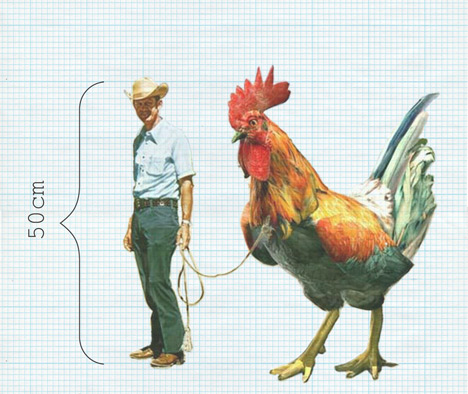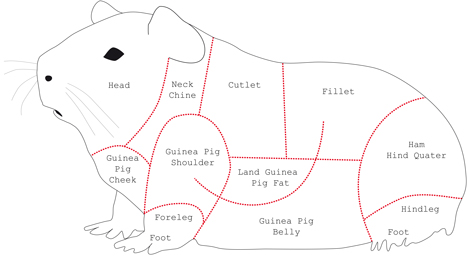The Incredible Shrinking Man by Arne Hendriks
Dutch Design Week 2013: Dutch artist Arne Hendriks proposes shrinking the human population to an average height of 50 centimetres as a way to reduce the amount of food and natural resources we consume.
The Incredible Shrinking Man is a speculative project devised by Arne Hendriks in response to the current trend for a taller population, which he claims is no longer "a desired result in an age of increasing scarcity".

Hendriks, himself almost two metres tall, accepts that the increased height of the global population is the result of better food, medicine, hygiene and living circumstances, but argues that being taller today represents "a burden, on ourselves and on the planet." He therefore presents a range of conceptual ways to reverse the trend.
"At 50 centimetres we’d only need about 2-5 percent of the resources we need now," Hendriks points out. "If the 20th century was all about growth, perhaps the 21st century is about downsizing."

His proposals for obtaining the "theoretical goal" of a universal height of 50 centimetres include elixirs that support slower growth and genetic growth experiments with zebrafish. Hendriks also organised a party in Beijing celebrating lactose intolerance, as the inability to digest milk contributes to slower growth.
Despite potential disadvantages, such as a brain size that "wouldn’t be much bigger than a walnut", Hendriks claims that the height reduction would allow the entire global population to fit in the world's six largest urban centres, leaving the rest of the planet free for agriculture. Only renewable energy would be needed and "one chicken will feed a hundred".

Initiatives undertaken as part of The Incredible Shrinking Man project include investigative workshops, exhibitions and the creation of a Disproportionate Restaurant that serves portions tailored to the 50-centimetre-tall customer of the future.

The project won the Future Concepts category at last week's Dutch Design Awards, where the selection committee said: "It is performed with so much zest that you can only take the idea seriously."
The top prize went to Iris van Herpen's fashion collection featuring 3D-printed garments.
Here's some more information about the project:
The Incredible Shrinking Man
It's been a long established trend that people become taller. As a direct result we need more resources, more food, more energy and more space. The body has become a materialization of our obsession with growth. But what if we tried to turn this around? What if we use our increasing knowledge of the human body to shrink? If the 20th century was all about growth, perhaps the 21st century is about downsizing. And that doesn't have to be a bad thing.
The Incredible Shrinking Man is a speculative research project that investigates what it would take to downsize the human species to better fit the Earth. At first this seems like a preposterous idea, but certainly not more preposterous than the irrational appreciation of the fact that we continue to increase in size. We've long surpassed the limits of the healthy. At The Incredible Shrinking Man the greenhouse effect isn’t about CO2, it's about people growing beyond natural limits because of their sheltered lives, much like plants in greenhouses. What happens when circumstances change? Auxologists like Robert Fogel and John Komlos continue to point out that global increased body height is the result of better food, better hygiene, better medicine and better living circumstances. And although increased height may indeed be the result of such improvements, height itself is not healthy and the question is if it is still a desired result in an age of increasing scarcity.
If your height increases by 20%, your body grows proportionally in all directions (1.2 x 1.2 x 1.2 = 1.73). That means your weight actually increases by 73%. All that extra weight needs extra food, extra water, extra energy. From an evolutionary perspective being taller at some point in history undoubtedly represented an advantage. In this day and age however it's a burden, on ourselves and on the planet. That's why The Incredible Shrinking Man proposes to shrink the human species to 50cm. Again, this seems radical, but perhaps less so if you consider that the shortest person alive today, Chandra Bahadur Dangi from Nepal, is only a little over 54 centimeters tall. Thus 50cm is our theoretical goal, so as to make sure we map all known possibilities, and a little beyond. At 50cm we’d only need about 2% to 5% of the resources we need now, and although it is an extreme goal it's also familiar because most babies are born this size.
Obviously there are many challenges in achieving an average universal human height of 50cm. For example, our brain size wouldn’t be much bigger than a walnut. One of the researchers for The Incredible Shrinking Man, Don Platt, is collecting evidence that brain cells could be much smaller without losing their function. It might even make us smarter since the distance an impulse has to travel is shorter. Other things are more difficult to control. How threatening would your cat become and what kinds of problems would large insects pose? What about the weather? Hail storms would become extremely dangerous. But we're human. If anything, we've an established track record with proving our ingenuity in overcoming even the most difficult challenges. Also fear is a very unrewarding impulse if you're trying to achieve new visions for mankind so at The Incredible Shrinking Man we like to think more of the adventures and new possibilities such a radical new idea would facilitate.
One of the most rewarding results of our shrinking would be the overwhelming and sustainable abundance of the natural and cultured environment. We would in fact shrink into a world of abundance. Renewable energy produced today would be more than enough to satisfy our demands. One tomato will make a decent soup and one chicken will feed a hundred. Redesigning the already built environment would take all of our imagination and inventiveness. Up to 95% of the cities could be recycled, condensed, 're-wilded', or just left as a cultural and material resource for future generations. The Incredible Shrinking Man calculated that at 50cm the entire world population would be able to live in the six largest agglomerations, Tokyo, Mexico City, Sao Paulo, Mumbai, Delhi and New York/Newark - leaving the rest of the world empty, or turned into agricultural lands. This redistribution of the human race would ask us to think of our relationship with the planet in ways unimaginable before.
The thing is that the Incredible Shrinking Man is actually working on a cultural paradigm shift. Away from our obsession with growth, towards an appreciation of smaller and less. It's both pro-active and a way of coming to terms with a change in reality. This is as much about investigating the actual possibilities as it is about redesigning our desires, our needs and our biological and cultural make-up. We need to re-educate ourselves. Within The Incredible Shrinking Man we run into manifestations, projects and products that can help the research transform itself into the actual change it pursues.
This can be the development of an elixir to support slow growth rates while reducing the chance of cancer, it can be a celebration of lactose intolerance, or a letter to the Congolese government to protect the 135cm Mbuti pygmees from genetic extinction. It can be genetic growth experiments with zebrafish, or shrink experience machines to get a sense of what it would be like to be smaller. The most important thing is that we start rethinking and embrace the possibilities of the small because like the famous economic thinker Ernst Schumacher said: "Small is beautiful".